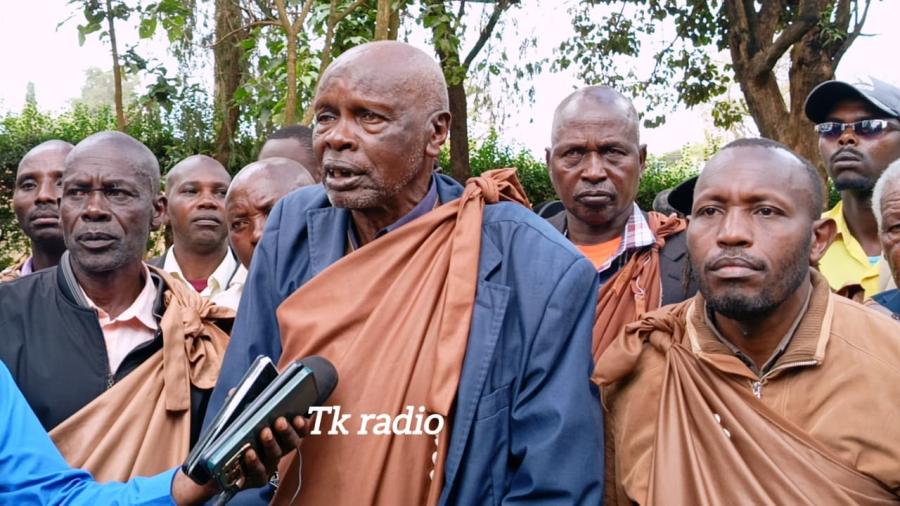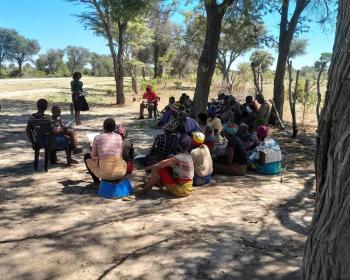"Our ancestors were here and now so are we," said Dawid Kruiper as his kin and following of 30-odd "stone-age huntergatheres" emerged from two minibuses, to the delight of journalists and photographers there to record the event. On January 15, 1991, after an absence of two centuries, the Bushmen had returned to the western Cape Province of South Africa.
The place they have returned to is the Kagga Kamma nature Reserve, a tourist resort in the Cedarberg Mountains. Here three white landowners have developed an entrepreneurial project to restore to their "natural" landscape a family of its first inhabitants. It is a landscape that still bears traces of ancient occupancy - score of Bushman painting on the surrounding rocks survive in testimony to the lives of vanquished people.
THE OFFICIAL STORY
Encroaching white settlers drove Bushmen out of the western Cape in the closing years of the eighteenth century, after a protracted and bloody frontier conflict. Today, a few thousand Bushmen live in the arid northern interior, and lees than a hundred are said to remain within the borders of South Africa. Those resettled at Kagga Kamma come from the southern fringes of the Kalahari desert, bordering Namibia and Bostwana, where they had previously suffered most of their lives in landless poverty.
Now the owners of the Kagga Kamma Reserve claim to have developed a dual strategy for the survival of these people and their heritage, snatching both from the verge of extinction. On the one from the verge of extinction. On the one hand, it has been announced, the Bushmen can live according to their traditions and exploit the natural environment for their subsistence. On the other, they and their customs are exhibited to tourists in what are marketed as unique cultural and educational encounters. They also earn a living making artifacts that are sold in the resort's curio shop.
Such is the official story, conveyed to the public in enthusiastic press and television releases, as well as in a series of glossy advertisements. The scheme appears to be nothing less than an enlightened exercise in "cultural survival," am affirmation of the value of indigenous traditions that is exemplary in the context of the new South Africa.
But the "restoration" that has occurred at Kagga Kamma is by no means unproblematic. Tourists and Bushmen meet at the reserve through an itinerary of carefully orchestrated performances. Ar a reconstructed forager camp, men display their prowess with bow and arrow while women thread ostrich-bead necklaces. During the day, trackers lead hikes through the veld; in the evening they dance and tell stories.
Behind the scene, however, when visitors retire to their "luxury Bushman hut" chalets, the Bushmen themselves exchange their loincloths for Western rags and go home to a shanty settlement that is hidden from the public gaze. In this latter camp, their behavior is circumscribed in the authoritarian manner familiar to most indigenous people residing on white-owned land in rural South Africa. Without legal protection in the enterprise, they receive no pittance for their handicrafts. Their housing is squalid, and the school and other amenities promised them on their arrival have yet to materialize. Forbidden access to all but the smallest game, they in fact make almost no use of their hunting "rights." Instead, they buy canned provisions from the local supply store, to which most are deeply in debt.
Responding to these conditions, a few have returned to the Kalahari. Those who remain privately threaten similar action if a better deal is not struck, and do so by means of evocative historical allegory:
There were Bushmen here in the past but where are they now? The whites brought sheep, and the Bushmen had to work for them, but they became hungry and stole the sheep, and the whites chased them out. This is a white man's world now. There's no place here for Bushmen. I went hunting today, but all I got was a can of pickled fish. Those thing are going to happen again, so we must leave before it comes to that.
Surprisingly, however, some of the dissidents have come back to the reserve and still more of their relatives have joined the enterprise. All remain remarkably committed main remarkably committed to the project of their "cultural survival" itself. Since these people - performers and makers of handicrafts for the global tourist economy - are clearly not stone-age foragers, what is the "restoration" of Bushmen culture at Kaga Kamma really about> And why do the Bushmen remain there after more than two years of maltreatment?
The answer to these questions lie in the very images of their identity that underwrite the venture. Implicit in the performances, advertisements, and media releases that form the public face of Kagga Kamma is the icon of the "pristine hunter-gatherer" - the familiar portrayal of Bushmen as Paleolithic foragers, isolated from the passage of progress in remote desert areas of southern Africa. In some cases, it is commonly held, their lifestyle remained pure in these regions until only pure in these regions until only four decades ago - but is now in danger of disappearing.
This image grossly distorts historical and enhnographic realities in many respects. Bushmen have long been part of a regional society dominated by African and, later European settlers, and it is precisely in the course of interaction with these settlers that they have been subjugated and murdered. Nor are Bushmen only hunters and gatherers: they have also been bandits, herders, guerrillas, slaves, migrant workers, and arm laborers.
RESCUE" SCHEMES
Through a multitude of representations, based on Western romantic myths of an Edenic idyll, the icon is nonetheless firmly implanted in the popular imagination. it is precisely what attracts tourists to kagga Kamma, generation profits for its owners.
If this is Kagga Kamma's global cultural framework, its particular tensions are also rooted in the specifics of the Bushmen's life stories. As told by the Bushmen themselves, these stories begin in the early 1930s, when they lost access to land in the southern Kalahari. Through the area had been inhabited from the mid-nineteenth century by "colored" settler, most of them had since been displaced by absentee speculators. This afforded local Bushmen relatively free rein in what they idealize now as a golden age of traditionalism and autonomy.
In 1930 and 1931, however, the South Africa state proclaimed a national gamepark (the Kalahari Gemsbok Park) and a reserve for "colored" farmers on this land. The Bushmen were cast into a cycle of destitution and "salvation" of which Kagga kamma is only the latest phase. "Everything was perfect before," recalls one Bushmen. "There were no fences there, just Bushmen tracks. Then the farmers arrived, and now everything is closed to us. We have no land, no water, no meat, and nowhere to rest."
Following the creative efforts of a concerned professional hunter, Bushmen initially received residence and hunting rights in the Kalahari Gemsbok Park, where some also found work as fame wardens. But with their standing there progressively eroded by hostile official, they were finally evicted in the early 1970s. For most f the last 20 years they have survived through casual wage labor for farmers on the very land they claim as their own by aboriginal right.
In an experience of proletarianization entailing poverty and insecurity, these families have also regularly been separated from each other in their quests for a livelihood, and thus deprived even of mutual support. Twice, however, they have been "rescued" yet again by entrepreneurs who have promised their "old life" back in return for participation in commercial ventures: for three years in the year 1980s they starred in films and other promotions, and now they perform at kagga kamma.
The Primary motivation behind such offers is an interest in the potential market value of the Bushmen heritage. The Bushmen's position has consequently also depended on being recognized as authentic in the less cynical advocacy that gained them rights in the Kalahari Gemsbok Park was motivated in terms f the value to science of their "unique and ancient" systems. Yet, by the same token, whenever they have become a burden to their patrons, the retraction of support has been rationalized by claiming that they have lost" that heritage.
Profoundly vulnerable to the ascriptions of powerful and wealthy outsiders, the Bushmen have been led by their experiences to attach particular importance to their cultural identity. Their Bushman-ness offers pride in their past, a critique of their present dilemmas, and hopefully a resource for prosperity in the future. Despite their eexploitation in recurrent "rescue" schemes, they are bitterly aware of being better in these than on the farms. Although the promises of restoration are constantly betrayed, the rhetoric f ventures such as Kagga Kamma publicly affirms the unique and preservable status that is their only hope for a better existence: "The tourists have never met people in skins, s it's a miracle for them. The day we put on (Western) cloths, they will stop coming. If I go back to the farms I have to put on cloths to work, and then I get little money."
The Kagga Kamma venture is woven at the intersection of all these trails of myth, history, and money. Tourists, owners, and Bushmen all have their own reasons for have to do with a resonant" - motives that have to do with a resonant, if ultimately fictive, ideal of what Bushmen should be. Yet unlike the others, the Bushmen themselves are trapped in a corner of dependency. As long as their control - and around an image of themselves that is not of their own making and that they are unable to manage to their own benefit - they seem destined to remain there.
Article copyright Cultural Survival, Inc.


